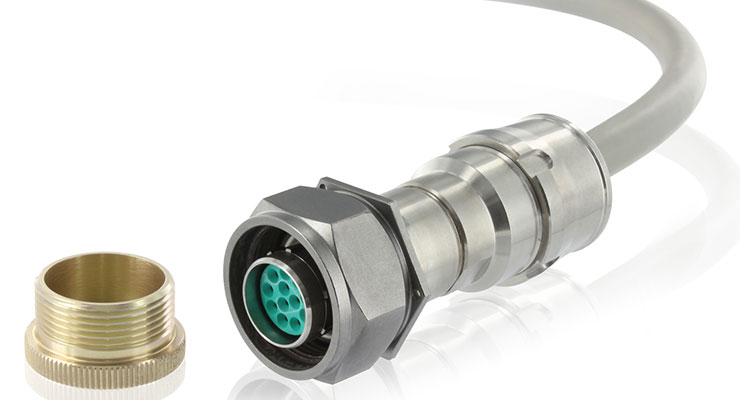Many industries require connectors to interconnect the electrical and electronic systems that are vital to controlling their processes and ensure the safety of equipment. The nuclear industry is no exception to this.
Thanks to its many years of collaboration with leaders in the industry, Souriau possesses extensive experience in meeting the requirements of nuclear environments.
 It is easy to understand that the operating conditions for equipment used at a nuclear power plant (NPP) and the operations involved in the nuclear fuel cycle are not the same. The connectors used inside a nuclear reactor are only disconnected and reconnected during maintenance outages and must ensure tight connections over periods of 40 to 60 years. Connectors used in the fuel cycle, however, are frequently disconnected and reconnected and the harsh environmental conditions mean that they must be robust and easy to handle. The three K1, K2, and K3 qualification levels that are specific to NPP environments make it possible to meet the safety requirements in various areas of use.
It is easy to understand that the operating conditions for equipment used at a nuclear power plant (NPP) and the operations involved in the nuclear fuel cycle are not the same. The connectors used inside a nuclear reactor are only disconnected and reconnected during maintenance outages and must ensure tight connections over periods of 40 to 60 years. Connectors used in the fuel cycle, however, are frequently disconnected and reconnected and the harsh environmental conditions mean that they must be robust and easy to handle. The three K1, K2, and K3 qualification levels that are specific to NPP environments make it possible to meet the safety requirements in various areas of use.
Connectors that withstand any harsh condition
Current standards that apply to NPPs include ISO 9001 and RCC-E (Design and construction rules for electrical equipment of nuclear islands). RCC-E is specific to the nuclear industry. Published by the French authorities, it contains more than 400 pages of rules on the design, manufacture, materials, qualifications, and testing of components and equipment. The other major standard is published by the IEEE Standards Association and is similar to RCC-E. China is currently drafting a protocol that is based on these two standards.
Over the years, Souriau’s 8NA K1-qualified screw-lock connectors have been modified to meet the requirements of European Pressurized Reactors (EPR) and now feature shells and receptacles fitted with stainless steel electromagnetic shields. These connectors come in two shell sizes and accommodate 16 and 20-gauge contacts in pin layouts of 3 to 24 contacts. The arrangement most commonly used for connecting sensors and instrumentation inside NPPs consists of twelve 20-gauge contacts. The 8NA series is RCC-E K1 qualified, meaning that it has passed a series of tests, the most important of which include simulation of the lifespan of a NPP (40 years), radiation resistance, simulation of an earthquake and accident, vibration resistance, and resistance to very high pressures. These severe tests are conducted by an independent laboratory over a one-year period and are then validated by experts at EDF (France’s electricity supplier).
Fuel cycle, hot cells and glove boxes
The conditions inside hot cells are harsh: radiation and temperature levels are high and chemicals are ever present. In most cases, operators have to use remote manipulators or sealed gloveboxes in order to handle equipment and objects. Although the connectors inside hot cells and gloveboxes are not subjected to the same conditions as those inside reactors, they are frequently mated and detached. They therefore must be easy to handle, long lasting, reliable, and resistant to radiation and chemicals. Souriau’s ULC push-pull connectors meet these four requirements. They come in four shell sizes and 45 layouts that accommodate coaxial, power, and signal contacts. By design, they are bulkier and feature longer shells and pre-guidance forks for easier handling via manipulators and gloveboxes. This connector family also features sealed bulkhead penetrations for connections between the inside of the containment and the outside environment.
Souriau’s Paris-Est site in Marolles-en-Brie occupies a special position in the company’s industrial operations. It is here where products that meet specific markets such as the nuclear industry are designed and manufactured. The engineers at the Paris-Est site work in close collaboration with research institutes and key buyers. The manufacturing processes are rigorous and highly codified. For example, an operator assigned with producing a batch of connectors makes an oral commitment via a process that summarizes the various inspections required during the manufacturing process.
Axel Paré, product manager for nuclear-grade connectors, noted, “Souriau’s experience in the nuclear industry makes it one of the few manufacturers in the world capable of offering nuclear-grade interconnection solutions. We have established a strong market presence in Europe and the USA. China represents a huge potential for growth and we are working to achieve this from our office in Shanghai. More than 6,000 K1, K2, and K3 connectors are produced at Marolles-en-Brie each year. Nuclear energy is a long-term market that requires an ability to anticipate trends and a level of consistency. In the case of our new products, we work with research institutes like CEA and we have just received EDF qualification for half-connector wiring harnesses. We are also looking into the possibility of integrating fiber optics into our connectors. Although the nuclear industry accounts for just 5% of Souriau’s turnover, it is a model in terms of design and manufacturing methods, rigor, and quality that has benefited the entire group.”
Souriau USA/Esterline Connection Technologies
www.esterline-connection-technologies.com

Leave a Reply
You must be logged in to post a comment.